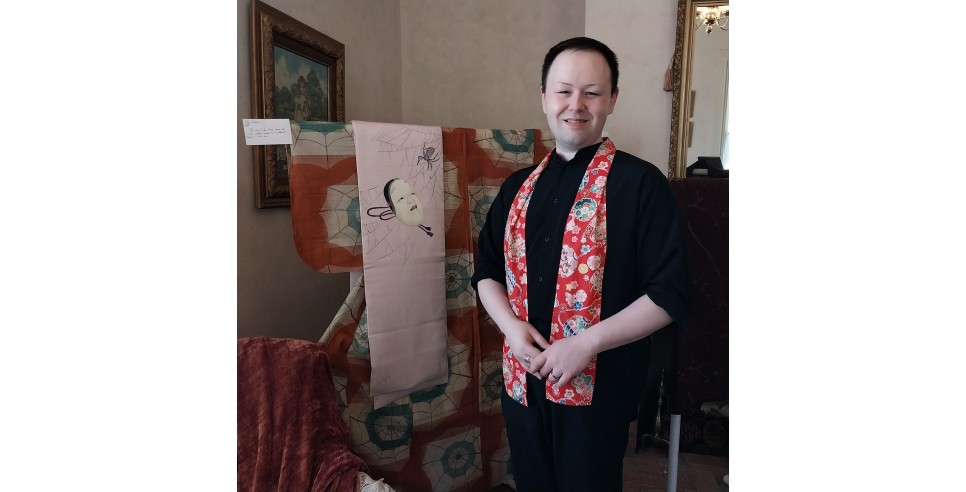
The embrace of fast fashion may be the prevailing trend of this generation of American consumers, but Devin Dondero has been heading in an entirely different direction. Long intrigued by the birthplace and cultural background of his paternal grandmother, Dondero has immersed himself in learning everything he can about the nuance and style of a Japanese fashion tradition that stretches back over a thousand years.
The kimono is all about elegance of embellishment, but simplicity of line. Through the centuries, as European fashions whipsawed through high waistlines, low necklines, ruffles, bustles, turtlenecks, wide ties, tie-dye and miniskirts – the Japanese kimono serenely maintained its basic, T-shaped fabric elements, its cylindrical form on the body, and the wide sash called an obi.
Dondero has a passion for fashion history, sparked early on by his enjoyment of nihon buyo – a popular traditional Japanese dance style in which dancers wear colorful kimonos as their costumes.
He began collecting kimonos about 15 years ago. The first piece he ever bought was at a downsizing sale held by an elderly Japanese-born woman who had moved to the United States after World War II and resettled in Tacoma, Washington.
She shared a story that compelled him to buy the simple silk garment. During the war, her family had lived close to factories that became primary bombing targets.
“Whenever they had air raids they’d all go into the shelter, and take their most precious things with them,” Dondero recalls. She always took the kimono.
“She told me that it had been gifted by her father. It was the last gift he had given her.”
Many decades later, of course, the kimono was no longer in perfect condition. The cream-colored silk had been stained by the wood box it had been kept in over the years.
But when the old woman told Dondero that she didn’t have anyone to pass it on to, he knew he had to become its next caretaker.
That kimono became the first in a collection that has now grown to around 90 pieces. Dondero says that he has acquired a mix of antique, modern, and designer kimonos. The oldest garment in his collection dates back to the 1870s, but he also has some 21st century pieces.
A number of the kimonos he owns employ spiderweb designs.
“It’s the ‘Goth’ look of Japanese dress,” Dondero quips.
Actually, spiderwebs are interpreted in several different ways in Japanese folklore.
The legend of the jorōgumo spider, for example, stems from an Edo period folktale in which an alluring woman seduces prospective swains into a web of deceit, then transforms herself into a spider to eat them.
On a cheerier note, a popular Japanese superstition holds that whenever somebody walks into a spider web, they’re bound to make a new friend that day.
Dondero says that he is also particularly drawn to kimonos with iris themes because he cherishes a childhood memory of a flowerbed his mother cultivated that featured a veritable rainbow of different iris varieties.
Other pieces in his collection display chrysanthemums, traditional drums, pine boughs, cherry blossoms, and other patterns that are symbolic in Japanese culture. The images may be painted, dyed, embroidered or printed. The fabrics range from silk to cotton and, more recently, synthetic fabrics.
Dondero notes that while the kimono style has been around for a millennium, Japan’s status as a fairly isolated nation-state for much of that time meant that kimonos relied on a fairly conventional set of patterns over many generations.
It wasn’t until Japanese society began to open up to Western trade in the 1850s that the influence of other cultures began to be reflected in kimono design. The motifs became more varied, borrowing from Arabesque, Indian and Western concepts. The color palette became bolder. And by the mid-20th century, the kimono silhouette itself began – subtly – to reflect the influences of Chanel chic and Dior drama.
Conversely, cultures outside of Asia began incorporating Japanese elements into their own aesthetic.
Dondero also collects kimono accessories and related items, including combs, wigs, and even carefully crafted traveling vanity cases.
“Honestly, it’s a hoarding situation,” he says with a laugh. “You find one thing and you just roll with it.”
But joking aside, this collector wants to share his enthusiasm for the meticulous artistry and minute detail that go into the kimono art form.
To that end, in June he displayed a generous sampling of his collection at a recent daylong event at the Neely Mansion, a national historic site located just outside of Auburn, WA. The Mansion’s past residents have included Japanese farming families, and the grounds include a restored historic Japanese furoba (bathhouse), so the match-up was ideal.
Even so, Dondero was pleasantly surprised by the enthusiastic response. The exhibit brought in a crowd of visitors and resulted in extra donations for the historical organization that runs the site.
“The enthusiasm opened up my eyes,” he said. “I didn’t expect the interest to be as large as it was.”
Now he’s hoping to do similar showings elsewhere, and hearkens back to what it was that made him buy that very first kimono: “The power of clothing and cultural dressing is a great vehicle for relation and experience and storytelling.”
For more information, contact Dondero directly at murisakishikibu@yahoo.com
Barbara Lloyd McMichael is a freelance writer living in the Pacific Northwest.









